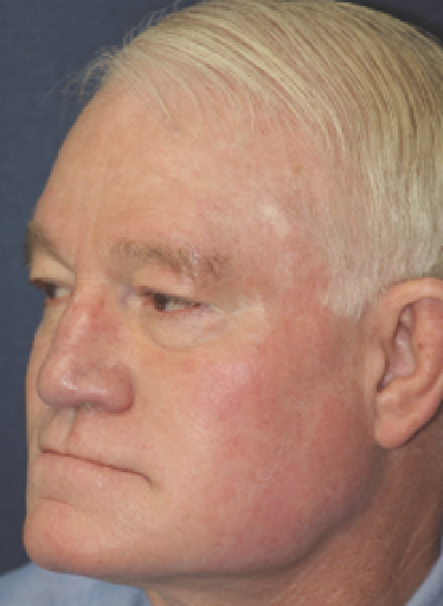Biomedical Engineering Reference
In-Depth Information
36 hours. The patient is to remain indoors, out of
direct sunlight.
4. Patients are given Avene Thermal Spring Water spray
to apply to their skin 4-6 times a day.
5. Repeat the treatment in 4-8 weeks. If there was little
reaction, increase the incubation time or reevaluate
your skin preparation technique.
a history of cold sores and appropriate HSV prophylaxis begun
prior to treatment in such cases (18).
Pain management, especially with shorter incubation times
(e.g., 1 hour), is usually a nonissue. Reassurance to the patient
and “talk-esthesia” by a caring member of the clinical staff is
usually more than adequate to comfort any patient anxiety
and pain. However, the use of cooling fans, Avene Thermal
Water Spray, forced air cooling systems, Xylocaine spray, and
even oral non-narcotic pain medication have been used suc-
cessfully to mitigate pain during ALA-PDT (22,67,88).
Patients should be counseled to practice strict photoprotec-
tion for 24-36 hours following treatment. Titanium dioxide-
and zinc oxide-containing sunblocks are preferred, in addition
to protective clothing and sunglasses. Excessive UV radiation
from sunlight, as well as intense spotlights, photocopy
machines, photographic fl ashlights, and medical examining
lights/lamps should be avoided during the period of photo-
sensitivity. Indoor light is usually not a concern, but patients
should avoid bright sources of light, even while indoors (40).
Not unexpectedly, if patients require a second treatment, the
adverse effects as well as treatment pain are usually much less
than those experienced with the initial treatment. We believe
that the decrease is due to the resolution of most of the clinical
and subclinical photodamage which occurs during the initial
treatment.
Clinical examples of AKs treated with a multilaser PDT approach
are presented in Figures 10.15 and 10.16.
Safety, Adverse Effects, and Complications
Expected side effects following PDT are related to the photo-
toxic nature of treatment and are usually mild in nature. Pain
and burning may be experienced during light irradiation.
Shorter incubation times decrease the severity of side effects.
Expected phototoxic side effects include erythema, edema,
stinging/burning, pruritus, and crusting. Pigmentary changes,
whealing, and vesiculation may also occur (40,67,69). Erythema
and mild crusting occur in most patients following treatment
(Fig. 10.17), usually resolving in 1-2 weeks (88). Hypopigmen-
tation is rare, and hyperpigmentation, with an incidence as high
as 27% following ALA-PDT (67), is usually mild in nature.
More pronounced reactions are correlated with disease burden.
Typically, repeat treatments are less painful than previous ones.
In patients with extensive phototoxic reactions (Fig. 10.18),
especially in cases when patients are exposed to UV radiation
in the 24-36 hours following treatment, topical therapy may be
necessary to address erythema, edema, and crusting. Topical
steroid creams and ice packs may be used on the treated area
until the symptoms subside. All patients should be screened for
Expected Benefits
Many of the benefi ts of ALA- and MAL-PDT treatment have
been addressed in the discussion of clinical studies regarding
the treatment of AKs and photorejuvenation. Both ALA- and
MAL-PDT are safe, effi cacious, and well-tolerated treatment
(
A
)
(
B
)
Figure 10.15
(
A
) Before and (
B
) 1 month after a single multilaser aminolevulinic acid-photodynamic therapy to the face of a middle-aged male with reduction in
actinic keratosis along with improvement in signs of photoaging, including solar lentigines and erythema.



















